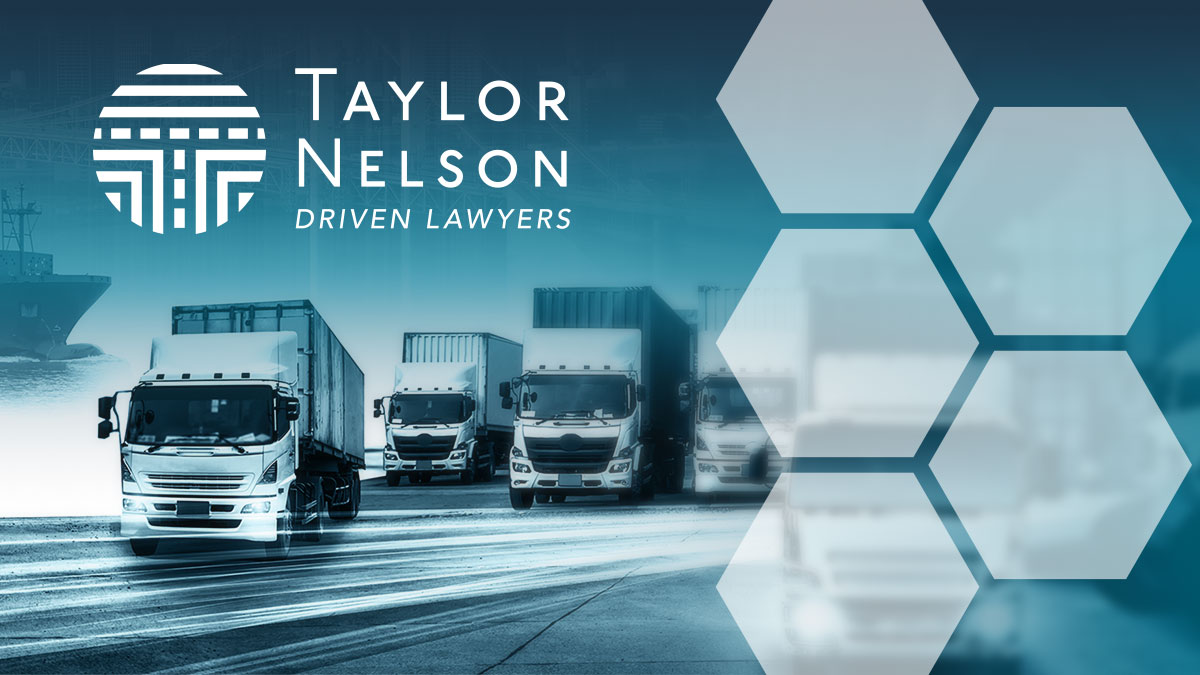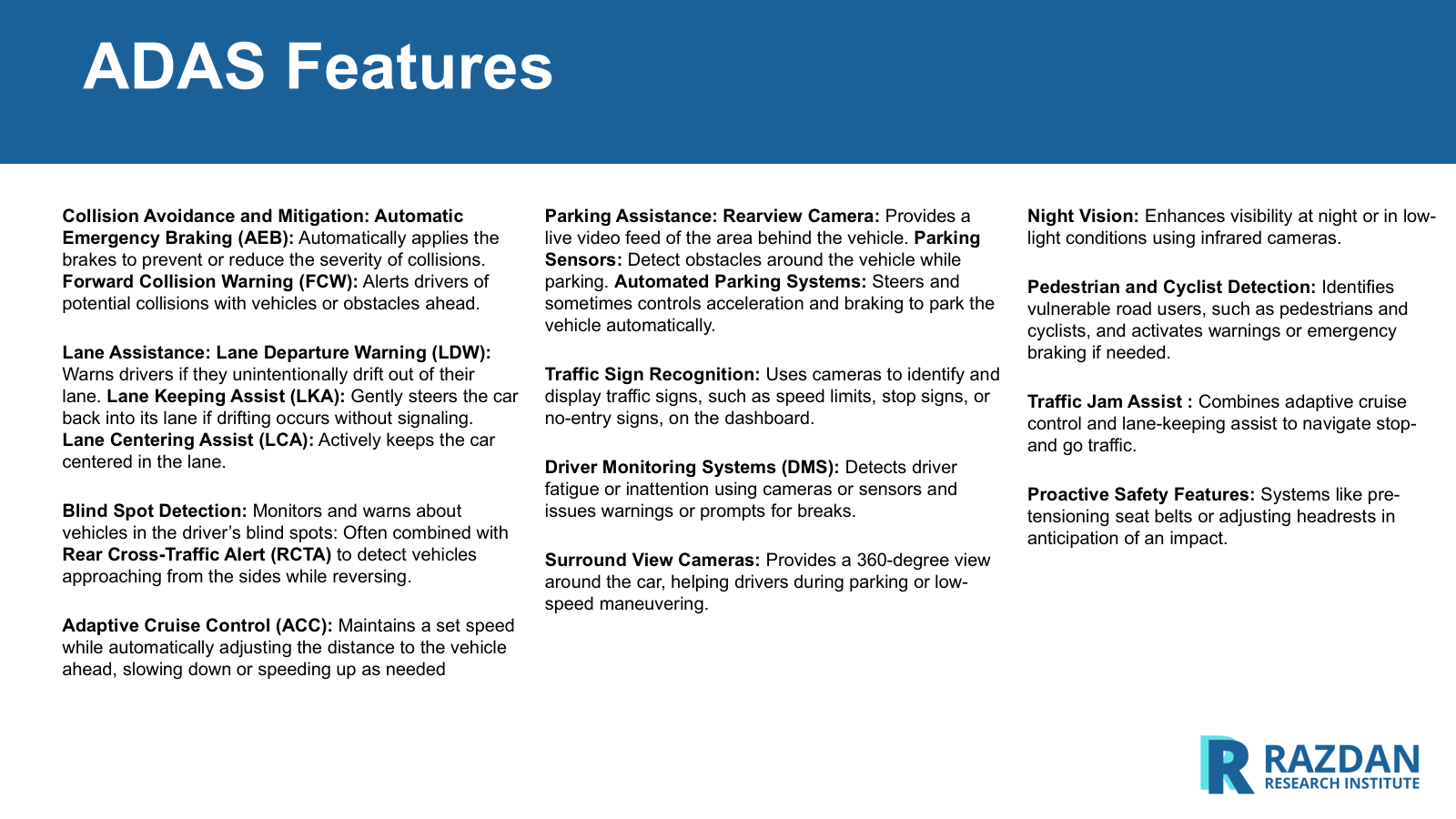by Rahul Razdan* and J.W. Taylor**
Summary:
Various aspects of ADAS for vehicles have seen some reasonable success. In this position paper, we propose that ADAS capabilities should be coupled with communication technology to enhance communication between vehicles and micro mobility players who share the road. This is especially important for vulnerable road users such as pedestrians and bicyclists. This next stage of ADAS technology can enhance safety as well as improve traffic operations.
ADAS For Vehicles:
ADAS (Advanced Driver Assistance Systems) are a collection of technologies designed to improve vehicle safety by assisting drivers in various driving scenarios. These systems use sensors, cameras, radar, and other technologies to detect obstacles, monitor the surroundings, and provide warnings or take action to prevent accidents. Figure one below outlines the current plate of ADAS solutions.
An increasing number of studies have shown the safety advantages of ADAS technologies.123 This is especially true for forward collision warning (FCW) and automatic emergency braking (AEB) where the Insurance Institute for Highway Safety (IIHS) found a reduction of front-to-rear crashes by 50%, and front-to-rear crashes with injuries by 56% while AAA found “AEB systems avoided 100% of forward collisions in testing at speeds up to 35 mph, compared to a 51% avoidance rate in older models (2017–2018).” More advanced ADAS capabilities such as lane departure systems are projected to reduce sideswipe and head-on crashes but unfortunately, also suffer from false-positive issues. Overall, a comprehensive analysis by LexisNexis Risk Solutions examined data from 11 million vehicles (model years 2014-2019) and found that the presence of at least one core ADAS feature led to substantial decreases in loss costs across various coverage types (Bodily Injury: 23% reduction in loss cost, Property Damage: 14% reduction, Collision Claims: 8% reduction). These findings suggest that ADAS technologies not only enhance vehicle safety, but also contribute to lower insurance payouts. Consequently, insurers for commercial and non-commercial vehicles are considering ADAS features in their policy rating processes, potentially leading to discounts for drivers of ADAS-equipped vehicles.4
Another exciting development is the use of ADAS for commercial trucking where forward collision warning (FCW), automatic emergency braking (AEB), lane departure warning (LDW), lane keep assist (LKA), blind spot detection, and adaptive cruise control (ACC) capabilities are being integrated into truck platforms. In addition, given the much larger mass of trucks, the Electronic Stability Control (ESC) system which prevents skidding and loss-of-control by automatically applying brakes on individual wheels is being integrated into a variety of systems. The impact seems to be very positive based on a study published in the IET Intelligent Transport Systems journal. The journal investigated the impacts of ADAS features such as forward collision warning (FCW), urban forward collision warning (UFCW), and lane departure warning (LDW) on commercial trucks. The findings indicated that these systems could significantly reduce the occurrence of accidents by providing timely warnings and interventions. These findings are well supported by the Federal Motor Carrier Safety Administration (FMCSA) which has published a guide highlighting the benefits of ADAS in commercial vehicles with the advice to include driver training which emphasizes the system limitations of ADAS and regular maintenance.5
Overall, FCW and AEB are quite effective and as the other capabilities mature, their effectiveness is expected to improve the conventional road traffic situation. One particular area which requires improvement is the handling of vulnerable road users.
Vulnerable Road Users and ADAS
Vulnerable road users (VRU) such as pedestrians and bicycles are increasingly more concerned with safety issues. As reported by Florida Department of Transportation (FDOT), vulnerable road users are only 4% of crashes but almost a third of fatalities (Figure 2). Further, this segment is likely to grow due to the megatrends of electrification and autonomy with a broader set of micro mobility devices (electric bike, delivery vehicles, scooters, etc.) as pointed out by a report from the Society for Automotive Engineering (SAE) report.6
Today, ADAS capabilities for vehicles have pedestrian and cyclist detection at various levels of completeness. On the VRU side, there are increasing capabilities on bicycles with radar systems which detect upcoming vehicles, specifically cars and trucks.7 In fact, because vehicles are such a hazard to bikers, bikers have a whole communication language with words such as “CAR BACK, STOPPING!, and CLEAR!” 8 For pedestrians, the lifesaving eye-contact at intersections or hand gestures for sidewalks is critical for safety.
A natural next step for ADAS systems is to communicate their recognition and intent to nearby micro mobility devices. The levels of the message could well be of the level of:
- “I see you.” This is the “eye-contact” moment for VRUs. Most importantly, if the vehicle does not see you, but you see it, this can generate an alert for the VRU.
- “I see you and I am waiting.” This communication helps with intersection efficiency as well as executing a passing maneuver on small roads.
- “I see you and I intend to pass.” This communication alerts the VRU to the passing event.
At a technological level, this sort of solution can be implemented with existing communication technology (5G or DSRC). VRUs commonly carry cell phones and modern vehicles have easy access to cellular technology.
Finally, there is emerging technology which uses communication technology to build a global view of situational awareness.9 For example, there can be individual vehicle accountability where the platforms assess the ability of nearby vehicles to act and move safely based on risk information in accordance with collectively determined paths. Perhaps the most important users of this technology may be commercial trucks whose impact on VRUs and non-commercial vehicles is “outsized.”
Could this be the beginning of a solution to reduce injury related crashes by convergence of these risk mitigating tools? We will have to wait and see.
*Dr. Rahul Razdan is a seasoned scientist and business executive who has had significant roles in the world of academia, startups, and fortune 500 companies. In corporate roles, he was the Sr Vice President of Strategy for Flextronics (FLEX), General Manager of the System and Functional Verification Business at Cadence Design Systems (CDNS), and Alpha CPU architect at Digital Equipment Corporation (DEC). He has successfully built successful startups in areas such wireless power, machine learning, and low-power electronics design.
In academia, beyond a large range of worldwide collaborations, he maintains academic appointments at the University of Florida, Embry-Riddle University, Tallinn University of Technology and Institute for Human Machine Cognition. Today, he is CEO of Raztech Research Institute, a technology based research institute which incubates ideas in the intersection of technology and society. He has a BS (1984) and MS (1985) from CMU and Phd from Harvard University (1994).
**J.W. Taylor is the founding member of the boutique transportation and logistics law firm, Taylor Nelson PL. Recognized as a Florida Super Lawyer and AV rated as a Preeminent Lawyer with Martindale-Hubbell, J.W. uses his industry experience to represent transportation and logistics companies in matters of claims litigation, including personal injury litigation and ADR, cargo claims and contract disputes. In addition to litigation, J.W. is skilled in corporate restructuring, insurance design, equipment financing and risk management matters. A frequent speaker on matters concerning the transportation and logistics industry, J.W. is a Thomas Ruke Fellow, a member of MCIEF, Transportation Lawyers Association (TLA), Transportation & Logistics Council (TLC), Transportation Intermediaries Association (TIA) and sat on the Florida Trucking Association (FTA) Board of Directors from 2019-2022. Currently, J.W. serves on the Public Policy Committee and Membership Recruitment Committee of the FTA as well as the Polk State Corporate College, Supply Chain Management & Logistics Advisory Board.
1 NHTSA finalizes key safety rule to reduce crashes and save lives. (2024, April 29). NHTSA. https://www.nhtsa.gov/press-releases/nhtsa-fmvss-127-automatic-emergency-braking-reduce-crashes
2 Cicchino, J. Effectiveness of forward collision warning and autonomous emergency braking systems in reducing front-to-rear crash rates. IIHS-HLDI Crash Testing and Highway Safety. Retrieved January 31, 2025, from https://www.iihs.org/topics/bibliography/ref/2111
3 Automotive Fleet Staff (2024, October 31). New study shows automatic emergency braking improves crash avoidance in 2024 vehicles. Automotive Fleet Magazine. https://www.automotive-fleet.com/10230837/new-study-finds-automatic-emergency-braking-improves-crash-avoidance-in-2024-veh
4 True impact of ADAS features on insurance claim severity revealed. (2024, November 7). LexisNexis Risk Solutions. https://risk.lexisnexis.com/insights-resources/white-paper/true-impact-of-adas-features-on-insurance-claim-severity-revealed
5 Wu, C., Cao, J., & Du, Y. (2022). Impacts of advanced driver assistance systems on commercial truck driver behavior performance using naturalistic data. IET Intelligent Transport Systems, 17(1), 119–128. https://doi.org/10.1049/itr2.12242
6 Razdan, R. Micromobility and the Next Infrastructure; EPR2024022 SAE International: Warrendale, PA, USA, 2024.
7 Garmin. VariaTM RTL515. Garmin. Retrieved January 31, 2025, from https://www.garmin.com/en-US/p/698001
8 CyclingTips, & CyclingTips. (2023, October 9). Verbal and Non-Verbal communication. Velo. https://velo.outsideonline.com/road/road-training/verbal-and-non-verbal-communication/
9 Noblis Research. (2020). In Noblis Pieces of Eight (Po8) Autonomous Vehicle Interoperability Concept [Report]. Noblis. https://noblis.org/wp-content/uploads/2020/01/Noblis-Po8-Research.pdf



